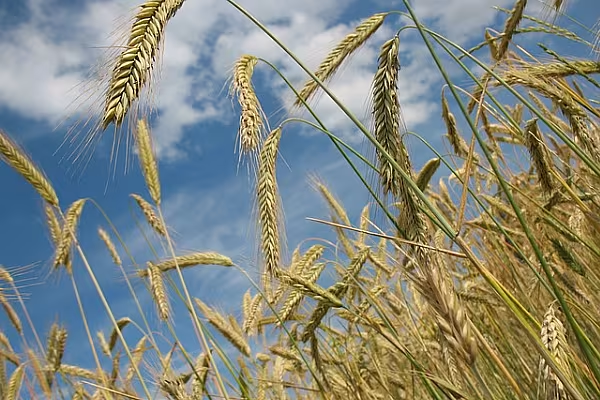Granola and oatmeal lovers in the US may need to prepare for some sticker shock.
Oat production in Canada, the world’s biggest exporter, is set to plunge after rain and snow delayed harvests across the prairie provinces. Because the crop spent too much time in wet fields, grain quality declined, which means more will end up as livestock feed and less will be suitable for making food products like Cheerios breakfast cereal.
Since the end of September, when the extent of the damage began to emerge, prices have rebounded from a seven-year low, staging the biggest harvest-season rally in a decade. More than 90% of Canada’s oat exports are sent to the U.S., where companies including General Mills Inc. and Quaker Oats Co. use them in everything from snack bars to cereals.
“You can’t make a Cheerio out of barley,” said Randy Strychar, the president of Oatinformation.com, an industry researcher based in Vancouver. “It’s going to be tight.”
Production will drop 13% to 2.98 million metric tonnes after lingering harvest delays, Agriculture and Agri-Food Canada said 17 November. Strychar says the decline may be as high as 20% because farmers were so far behind the normal pace of harvesting.
As of 15 November, farmers in Saskatchewan still hadn’t collected 10% of their crop while Alberta had 27% unharvested, data from the provincial governments show. A year earlier, the oat harvest was mostly completed by early November.
Oat futures on the Chicago Board of Trade are up 25% since the end of September, the biggest rally for this time of year since 2006. Before the harvest delays, prices on 13 September touched $1.71 a bushel, the lowest since February 2009. The most active futures contract closed Wednesday at $2.23 1/4.
Canada oat exports will drop to a four-year low of 1.5 million tonnes in the year that began 1 October, down from 1.6 million tonnes a year earlier, the US Department of Agriculture estimates. American food processors are dependent upon Canadian supply because US farmers don’t grow enough, which means they import about 57% of what they use.
General Mills, the Minneapolis-based company that makes products including Nature Valley granola bars and Cheerios cereal, declined to comment. Chicago-based Quaker Oats, a unit of PepsiCo Inc. that produces its eponymous hot cereals and granola bars, didn’t respond to a request for comment.
Quality Issues
Even if farmers managed to complete the harvest this week, the grain won’t be usable for foodmakers. The US may have to import more from northern Europe and draw down existing inventories to manage the supply rout, according to Strychar at oatinformation.com.
It may take a few months before oat buyers start to see higher costs because supplies had been ample from earlier harvests and prices were low, said Dave Sanders, a Vancouver, Washington-based vice president for Cereal Byproducts Co. The company, which gets about 80% of its oats from Canada, markets 10,000 tonnes annually for use by food makers and producers of pet food.
“After the first of the year, we’ll start seeing some increases,” Sanders said. “It will be a significant change in the market. There is still a lot of oats being stored on-farm from last year’s crop. That will temper the price a little bit.”
While oat inventories in the US midwest may be as high as 21 million bushels -- enough to last five months -- not all of it is food-grade quality, so millers may try to purchase more to make sure they don’t run out, said Ryan McKnight, a merchandising manager at Linear Grain Inc., a Carman, Manitoba-based company that originates, stores and transports crops.
“Mills ran out in 2014, and they don’t want that to happen again,” McKnight said.
Price Volatility
Ceres Global Ag Corp., a Toronto-based owner of agricultural assets, said 9 November that the harvest delays created “significant quality issues” and price volatility. The company, in an earnings statement, said it will focus on increasing the volume of grain sold.
In the US, the oat crop was collected earlier and generally had better quality, said Frayne Olson, an agricultural economist at North Dakota State University in Fargo. Still, because American food makers rely more on imports than domestic supply, getting quality oats may fetch a premium, he said.
It’s not clear how much of the Canadian crop will be usable in food, the USDA said in a 2 November report. The department lowered its forecast for Canadian oat inventories in 2016-17 to 765,000 tonnes from 795,000 tonnes, according to the report.
Canada’s crop will be key for American food companies because most other oat-producing countries consume most of what they grow, said Tregg Cronin, a South Dakota-based analyst for Halo Commodity Co. Food and seed demand, accounting for about half of USuse, is “inelastic,” he said. And makers of horse feed, another big source of demand, aren’t likely to switch to other grains.
“We rely on them for so much of our imports,” Cronin said of Canadian farmers. “That’s what makes this such a big problem.”
News by Bloomberg, edited by ESM. To subscribe to ESM: The European Supermarket Magazine, click here.














